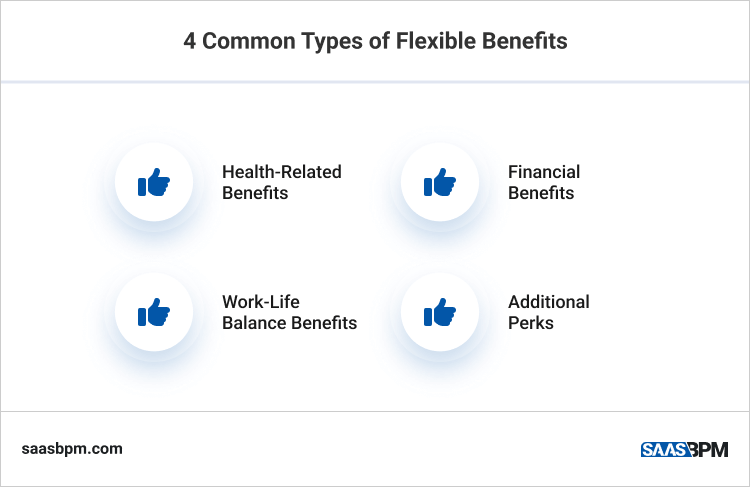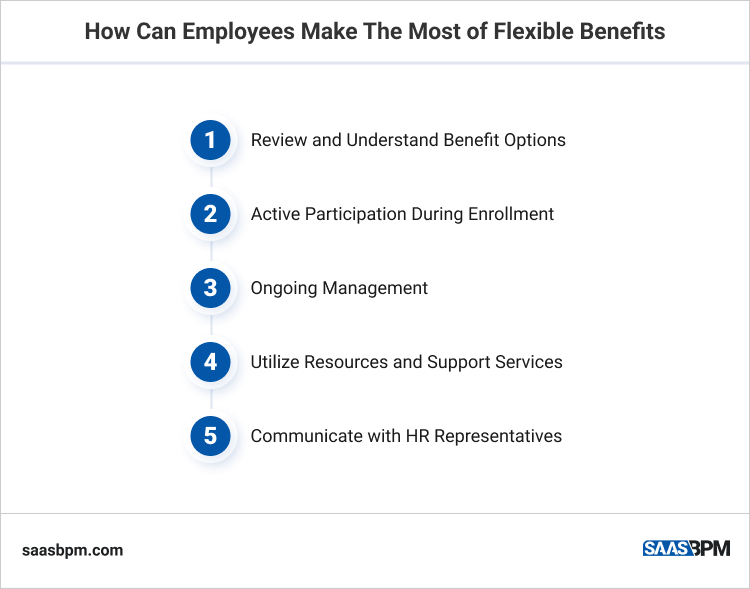In today’s workforce, diversity is key, with five generations working together. This presents challenges and opportunities for employers. They must understand and accommodate diverse needs and preferences.
Flexible benefits offer a solution. They allow employees to choose options that suit them best and bring about a more inclusive workplace.
Business owners can definitely find their own way to use flexible benefits for various purposes, be it for retaining top talent, provoking healthy competition or enhancing company culture.
In this article, we will delve into the core of flexible benefits, main types they are classified by, and actionable steps to introduce them effectively in your organisation.
What are Flexible Benefits and Why are They Important?
Flexible benefits are personalized employee benefit programs designed to empower individuals to select options suited to their specific needs. Unlike traditional one-size-fits-all benefits packages, flexible benefits offer employees a range of choices, allowing them to tailor their benefits to match their unique circumstances and preferences.
Also, flexible benefits are key to attracting and retaining top talent. Job seekers are increasingly prioritizing employers who offer comprehensive benefits packages that cater to their individual needs. This way, employers can differentiate themselves from competitors and position themselves as employers of choice.
Moreover, flexible benefits contribute significantly to employee satisfaction, engagement, and overall well-being. When employees have the flexibility to choose benefits that align with their lifestyles and priorities, they feel valued and supported by their employer. This, in turn, leads to higher levels of job satisfaction, increased engagement, and improved morale within the workforce.
Furthermore, flexible benefits are important for promoting diversity, equity, and inclusion at work. They help meet the different needs of employees, making everyone feel valued. For example, offering various healthcare options or flexible work schedules shows support for employees’ well-being, no matter their background or situation.
4 Common Types of Flexible Benefits

Employers today understand that a one-size-fits-all approach to employee benefits no longer suffices. In response, they’re increasingly offering a diverse array of flexible benefits to cater to the varied needs and preferences of their workforce. Let’s delve into some of the most common types of flexible benefits:
1. Health-related Benefits
- Medical Insurance.Employees are offered a range of medical insurance options, allowing them to choose plans that best suit their healthcare needs and budgets. This may include options for different coverage levels, deductibles, and provider networks.
- Dental and Vision Insurance.Similar to medical insurance, employees have the flexibility to select dental and vision insurance plans tailored to their individual requirements.
- Flexible Spending Accounts (FSAs) and Health Savings Accounts (HSAs).These accounts allow employees to set aside pre-tax dollars to cover qualified medical expenses. FSAs are typically funded annually and must be used within the plan year, while HSAs are associated with high-deductible health plans and offer greater flexibility and portability.
2. Financial Benefits
- Retirement Plans. Employers may offer various retirement savings options such as 401(k) plans, Roth IRAs, or pension plans. Employees can choose to contribute a portion of their pre-tax income to these plans, with some employers offering matching contributions.
- Stock Options. Companies may provide employees with stock options or equity grants, allowing them to purchase company stock at a predetermined price. This can serve as an attractive incentive for employees to align their interests with the company’s success.
- Employee Assistance Programs (EAPs). EAPs offer confidential counseling and support services to employees facing personal or work-related challenges. These programs may cover a wide range of issues, including mental health, financial concerns, and legal matters.
3. Work-life Balance Benefits
- Flexible Work Schedules. Employees may have the option to customize their work schedules to accommodate personal obligations or preferences. This could involve adjusting start and end times, compressing work weeks, or telecommuting arrangements.
- Telecommuting Options. With advancements in technology, many employers offer telecommuting or remote work opportunities, allowing employees to work from home or other remote locations.
- Paid Time Off (PTO). PTO policies typically combine vacation days, sick leave, and personal days into a single bank of time off that employees can use as needed.
4. Additional Perks
- Wellness Programs. Employers may offer wellness programs that promote employee health and well-being through activities such as fitness challenges, nutrition counseling, and stress management workshops.
- Tuition Reimbursement. Some companies provide tuition reimbursement programs to support employees pursuing further education or professional development opportunities.
- Childcare Assistance. Childcare assistance programs, such as subsidies or on-site childcare facilities, help employees balance their work responsibilities with childcare obligations.
How Can Employees Make The Most of Flexible Benefits

To maximize the value of flexible benefits, employees should adopt a proactive approach and follow these practical guidelines:
Review and Understand Benefit Options
Take the time to carefully review and understand the available benefit options. Assess your individual needs, preferences, and financial circumstances to make informed decisions that align with your priorities.
Active Participation During Enrolment
Actively participate during benefit enrollment periods to select the most suitable options for your situation. Don’t passively accept default selections; instead, customize your benefits to meet your specific needs.
Ongoing Management
Benefits needs may evolve over time, so it’s essential to regularly review and adjust your benefit selections as needed. Keep track of major life events or changes in circumstances that may warrant a reassessment of your benefits.
Utilize Resources and Support Services
Take advantage of online resources, educational materials, and support services provided by your employer to navigate flexible benefits effectively. These resources can provide valuable information and guidance to help you make informed decisions.
Communicate with HR Representatives
Maintain open and regular communication with HR representatives or benefits administrators to address any questions or concerns related to flexible benefits. Don’t hesitate to seek clarification or assistance if you encounter challenges or uncertainties.
Wrapping up
Flexible benefits are vital in today’s workplace, catering to diverse employee needs. They improve satisfaction, retention, and engagement for both employers and employees. Employers should regularly update flexible benefits to meet changing workforce needs. For assistance,feel free to explore more resources or consult HR professionals to enhance flexible benefits programs. Embracing flexible benefits shows commitment to creating a supportive, inclusive workplace focused on employee well-being and success.

